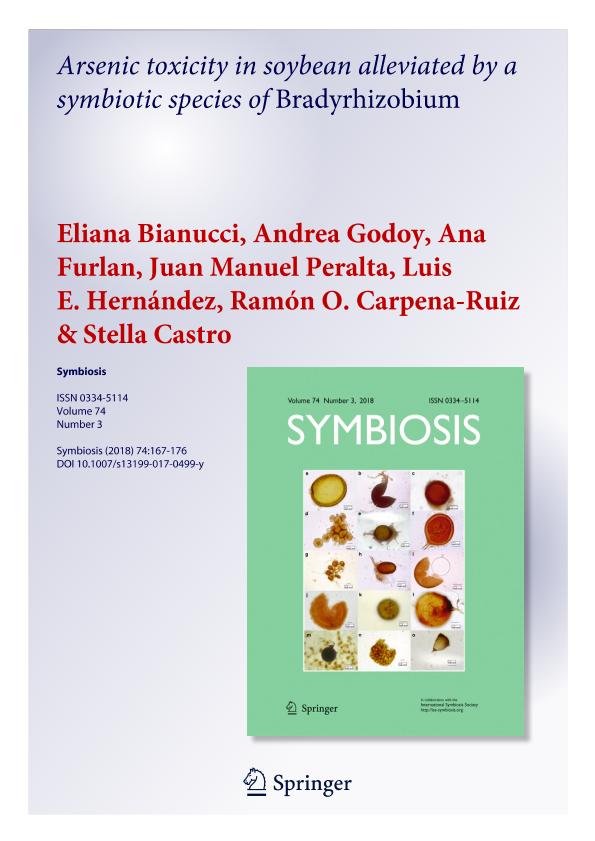Artículo
Arsenic toxicity in soybean alleviated by a symbiotic species of Bradyrhizobium
Bianucci, Eliana Carolina ; Godoy, Andrea; Furlan, Ana Laura
; Godoy, Andrea; Furlan, Ana Laura ; Peralta, Juan Manuel
; Peralta, Juan Manuel ; Hernández, Luis E.; Carpena-Ruiz, Ramón O.; Castro, Stella Maris
; Hernández, Luis E.; Carpena-Ruiz, Ramón O.; Castro, Stella Maris
 ; Godoy, Andrea; Furlan, Ana Laura
; Godoy, Andrea; Furlan, Ana Laura ; Peralta, Juan Manuel
; Peralta, Juan Manuel ; Hernández, Luis E.; Carpena-Ruiz, Ramón O.; Castro, Stella Maris
; Hernández, Luis E.; Carpena-Ruiz, Ramón O.; Castro, Stella Maris
Fecha de publicación:
03/2018
Editorial:
Springer
Revista:
Symbiosis
ISSN:
0334-5114
e-ISSN:
1878-7665
Idioma:
Inglés
Tipo de recurso:
Artículo publicado
Clasificación temática:
Resumen
Arsenic (As) is a toxic metalloid that has gained special interest in the past years as a global environmental problem. Groundwater in Córdoba province (Argentina) presents high As concentrations which can be absorbed by plants or be used for artificial irrigation. The aim of this research was to elucidate the differential responses of symbiotic interactions established with three bacterial strains and soybean plants to realistic doses of arsenic. The reference strain Bradyrhizobium diazoefficiens USDA110 and the native isolate Bradyrhizobium sp. Per 3.64 were able to grow up to 13 mM As(V) whereas the native strain Bradyrhizobium sp. Per 3.61 grew up to 9.5 mM As(V). Metalloid addition did not modify the soybean plant growth at 6 μM As(V). Nevertheless, it was enough to induce oxidative stress as observed by an increase on lipid peroxidation. The soybean-Bradyrhizobium sp. assay at 6 μM As(V) showed no changes in growth variables (shoot and root dry weight) in plants inoculated with the reference microsymbiont or Bradyrhizobium sp. Per 3.61. Regarding As uptake by plants, metalloid accumulation followed the same distribution pattern among strains. Remarkably, at 6 μM As(V), soybean inoculation with Bradyrhizobium sp. Per 3.61 revealed a significantly lower translocation factor (TF) in comparison to other inoculated strains promoting As phytostabilization. At the highest As(V) concentration tested, only Bradyrhizobium diazoefficiens USDA110 was able to nodulate the legume, however, a significant decrease in the number and dry weight of nodules and nitrogen content was observed. In conclusion, the inoculation of soybean plants with the reference strain Bradyrhizobium diazoefficiens USDA110 exposed to high As(V) concentration represents an effective and promising symbiotic interaction that allows the development of the legume due to the minimal effects on plant growth. However, in low As(V) concentration environments, the native isolate Bradyrhizobium sp. Per 3.61, is shown to be the best inoculant among the tested strains, owing to the limitation of metalloid translocation and accumulation to edible parts of the legume, avoiding fruit contamination and human poisoning.
Palabras clave:
ARSENIC
,
BRADYRHIZOBIUM SP
,
LEGUME
,
SYMBIOTIC INTERACTION
Archivos asociados
Licencia
Identificadores
Colecciones
Articulos(CCT - CORDOBA)
Articulos de CTRO.CIENTIFICO TECNOL.CONICET - CORDOBA
Articulos de CTRO.CIENTIFICO TECNOL.CONICET - CORDOBA
Citación
Bianucci, Eliana Carolina; Godoy, Andrea; Furlan, Ana Laura; Peralta, Juan Manuel; Hernández, Luis E.; et al.; Arsenic toxicity in soybean alleviated by a symbiotic species of Bradyrhizobium; Springer; Symbiosis; 74; 3; 3-2018; 167-176
Compartir
Altmétricas



